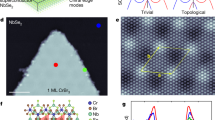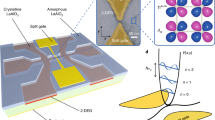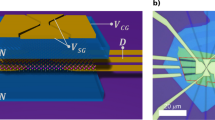Abstract
Two-dimensional semiconductors, such as transition metal dichalcogenides, have demonstrated tremendous promise for the development of highly tunable quantum devices. Realizing this potential requires low-resistance electrical contacts that perform well at low temperatures and low densities where quantum properties are relevant. Here we present a new device architecture for two-dimensional semiconductors that utilizes a charge-transfer layer to achieve large hole doping in the contact region, and implement this technique to measure the magnetotransport properties of high-purity monolayer WSe2. We measure a record-high hole mobility of 80,000 cm2 V–1 s–1 and access channel carrier densities as low as 1.6 × 1011 cm−2, an order of magnitude lower than previously achievable. Our ability to realize transparent contact to high-mobility devices at low density enables transport measurements of correlation-driven quantum phases including the observation of a low-temperature metal–insulator transition in a density and temperature regime where Wigner crystal formation is expected and the observation of the fractional quantum Hall effect under large magnetic fields. The charge-transfer contact scheme enables the discovery and manipulation of new quantum phenomena in two-dimensional semiconductors and their heterostructures.
This is a preview of subscription content, access via your institution
Access options
Access Nature and 54 other Nature Portfolio journals
Get Nature+, our best-value online-access subscription
$29.99 / 30 days
cancel any time
Subscribe to this journal
Receive 12 print issues and online access
$259.00 per year
only $21.58 per issue
Buy this article
- Purchase on Springer Link
- Instant access to full article PDF
Prices may be subject to local taxes which are calculated during checkout




Similar content being viewed by others
Data availability
The data relevant to figures in the main text are available via Zenodo at https://doi.org/10.5281/zenodo.10866111 (ref. 55). Additional raw data are available from the corresponding author upon reasonable request.
References
Wilson, N. P., Yao, W., Shan, J. & Xu, X. Excitons and emergent quantum phenomena in stacked 2D semiconductors. Nature 599, 383–392 (2021).
Mak, K. F. & Shan, J. Semiconductor moiré materials. Nat. Nanotechnol. 17, 686–695 (2022).
Shi, L.-k, Ma, J. & Song, J. C. W. Gate-tunable flat bands in van der Waals patterned dielectric superlattices. 2D Mater. 7, 015028 (2019).
Larentis, S. et al. Large effective mass and interaction-enhanced Zeeman splitting of K-valley electrons in MoSe2. Phys. Rev. B 97, 201407 (2018).
Shi, Q. et al. Odd- and even-denominator fractional quantum Hall states in monolayer WSe2. Nat. Nanotechnol. 15, 569–573 (2020).
Li, T. et al. Quantum anomalous Hall effect from intertwined moiré bands. Nature 600, 641–646 (2021).
Foutty, B. A. et al. Mapping twist-tuned multiband topology in bilayer WSe2. Science 384, 343–347 (2024).
Cai, J. et al. Signatures of fractional quantum anomalous Hall states in twisted MoTe2. Nature 622, 63–68 (2023).
Zeng, Y. et al. Thermodynamic evidence of fractional Chern insulator in moiré MoTe2. Nature 622, 69–73 (2023).
Park, H. et al. Observation of fractionally quantized anomalous Hall effect. Nature 622, 74–79 (2023).
Xu, F. et al. Observation of integer and fractional quantum anomalous Hall effects in twisted bilayer MoTe2. Phys. Rev. X 13, 031037 (2023).
Ma, L. et al. Strongly correlated excitonic insulator in atomic double layers. Nature 598, 585–589 (2021).
Nguyen, P. X. et al. Perfect Coulomb drag in a dipolar excitonic insulator. Preprint at https://arxiv.org/abs/2309.14940 (2023).
Qi, R. et al. Perfect Coulomb drag and exciton transport in an excitonic insulator. Preprint at https://arxiv.org/abs/2309.15357 (2023).
Allain, A., Kang, J., Banerjee, K. & Kis, A. Electrical contacts to two-dimensional semiconductors. Nat. Mater. 14, 1195–1205 (2015).
Wang, Y. & Chhowalla, M. Making clean electrical contacts on 2D transition metal dichalcogenides. Nat. Rev. Phys. 4, 101–112 (2022).
Liu, Y. et al. Approaching the Schottky–Mott limit in van der Waals metal–semiconductor junctions. Nature 557, 696–700 (2018).
Movva, H. C. P. et al. High-mobility holes in dual-gated WSe2 field-effect transistors. ACS Nano 9, 10402–10410 (2015).
Jung, Y. et al. Transferred via contacts as a platform for ideal two-dimensional transistors. Nat. Electron. 2, 187–194 (2019).
Xu, S. et al. Universal low-temperature ohmic contacts for quantum transport in transition metal dichalcogenides. 2D Mater. 3, 021007 (2016).
Shen, P.-C. et al. Ultralow contact resistance between semimetal and monolayer semiconductors. Nature 593, 211–217 (2021).
Borah, A., Nipane, A., Choi, M. S., Hone, J. & Teherani, J. T. Low-resistance p-type ohmic contacts to ultrathin WSe2 by using a monolayer dopant. ACS Appl. Electron. Mater. 3, 2941–2947 (2021).
Cai, X. et al. Bridging the gap between atomically thin semiconductors and metal leads. Nat. Commun. 13, 1777 (2022).
Mashhadi, S. et al. Spin-split band hybridization in graphene proximitized with α-RuCl3 nanosheets. Nano Lett. 19, 4659–4665 (2019).
Rizzo, D. J. et al. Charge-transfer plasmon polaritons at graphene/α-RuCl3 interfaces. Nano Lett. 20, 8438–8445 (2020).
Wang, Y. et al. Modulation doping via a two-dimensional atomic crystalline acceptor. Nano Lett. 20, 8446–8452 (2020).
Liu, S. et al. Two-step flux synthesis of ultrapure transition-metal dichalcogenides. ACS Nano 17, 16587–16596 (2023).
Cho, Y. et al. Modulation doping of single-layer semiconductors for improved contact at metal interfaces. Nano Lett. 22, 9700–9706 (2022).
Haratipour, N., Namgung, S., Oh, S.-H. & Koester, S. J. Fundamental limits on the subthreshold slope in Schottky source/drain black phosphorus field-effect transistors. ACS Nano 10, 3791–3800 (2016).
Wang, J. et al. Transferred metal gate to 2D semiconductors for sub-1 V operation and near ideal subthreshold slope. Sci. Adv. 7, eabf8744 (2021).
Li, S. S. (ed.) Semiconductor Physical Electronics (Springer, 2006).
Huang, Y., Shklovskii, B. I. & Zudov, M. A. Scattering mechanisms in state-of-the-art GaAs/AlGaAs quantum wells. Phys. Rev. Mater. 6, L061001 (2022).
Joe, A. Y. et al. Transport study of charge-carrier scattering in monolayer WSe2. Phys. Rev. Lett. 132, 056303 (2024).
Ma, N. & Jena, D. Charge scattering and mobility in atomically thin semiconductors. Phys. Rev. X 4, 011043 (2014).
Shih, E.-M. et al. Spin-selective magneto-conductivity in WSe2. Preprint at https://arxiv.org/abs/2307.00446 (2023).
Movva, H. C. P. Magnetotransport Studies of Tungsten Diselenide Holes. PhD thesis, The Univ. of Texas at Austin (2018).
Kamburov, D., Baldwin, K. W., West, K. W., Shayegan, M. & Pfeiffer, L. N. Interplay between quantum well width and interface roughness for electron transport mobility in GaAs quantum wells. Appl. Phys. Lett. 109, 232105 (2016).
Rhodes, D., Chae, S. H., Ribeiro-Palau, R. & Hone, J. Disorder in van der Waals heterostructures of 2D materials. Nat. Mater. 18, 541–549 (2019).
Fallahazad, B. et al. Shubnikov–de Haas oscillations of high-mobility holes in monolayer and bilayer WSe2: Landau level degeneracy, effective mass, and negative compressibility. Phys. Rev. Lett. 116, 086601 (2016).
Chung, Y. J. et al. Ultra-high-quality two-dimensional electron systems. Nat. Mater. 20, 632–637 (2021).
Chung, Y. J. et al. Record-quality GaAs two-dimensional hole systems. Phys. Rev. Mater. 6, 034005 (2022).
Falson, J. & Kawasaki, M. A review of the quantum Hall effects in MgZnO/ZnO heterostructures. Rep. Prog. Phys. 81, 056501 (2018).
Kravchenko, S. V., Kravchenko, G. V., Furneaux, J. E., Pudalov, V. M. & D’Iorio, M. Possible metal-insulator transition at B=0 in two dimensions. Phys. Rev. B 50, 8039–8042 (1994).
Chung, Y. J. et al. Multivalley two-dimensional electron system in an AlAs quantum well with mobility exceeding 2 × 106 cm2 V−1 s−1. Phys. Rev. Mater. 2, 071001 (2018).
Falson, J. et al. Competing correlated states around the zero-field Wigner crystallization transition of electrons in two dimensions. Nat. Mater. 21, 311–316 (2022).
Ahn, S. & Das Sarma, S. Density-tuned effective metal-insulator transitions in two-dimensional semiconductor layers: Anderson localization or Wigner crystallization. Phys. Rev. B 107, 195435 (2023).
Drummond, N. D. & Needs, R. J. Phase diagram of the low-density two-dimensional homogeneous electron gas. Phys. Rev. Lett. 102, 126402 (2009).
Smoleński, T. et al. Signatures of Wigner crystal of electrons in a monolayer semiconductor. Nature 595, 53–57 (2021).
Andrei, E. Y. et al. Observation of a magnetically induced Wigner solid. Phys. Rev. Lett. 60, 2765–2768 (1988).
Li, H. et al. Imaging two-dimensional generalized Wigner crystals. Nature 597, 650–654 (2021).
Polshyn, H. et al. Quantitative transport measurements of fractional quantum Hall energy gaps in edgeless graphene devices. Phys. Rev. Lett. 121, 226801 (2018).
Schulze-Wischeler, F., Mariani, E., Hohls, F. & Haug, R. J. Direct measurement of the g factor of composite fermions. Phys. Rev. Lett. 92, 156401 (2004).
Wang, Y. et al. P-type electrical contacts for 2D transition-metal dichalcogenides. Nature 610, 61–66 (2022).
Wang, L. et al. One-dimensional electrical contact to a two-dimensional material. Science 342, 614–617 (2013).
Pack, J. Data related to ‘Charge-transfer contacts for the measurement of correlated states in monolayer WSe2’. Zenodo https://doi.org/10.5281/zenodo.10866111 (2024).
Acknowledgements
This research is primarily supported by the US Department of Energy (DE-SC0016703). The synthesis of WSe2 (L.H., S.L. and K.B.) was supported by the Columbia University Materials Science and Engineering Research Center (MRSEC) through NSF grants DMR-1420634 and DMR-2011738. J.H. and C.R.D. acknowledge support from the Gordon and Betty Moore Foundation’s EPiQS Initiative Grant GBMF10277. A portion of this work was performed at the National High Magnetic Field Laboratory, which is supported by the National Science Foundation Cooperative Agreement no. DMR-2128556 and the State of Florida. D.G.M. and M.C. acknowledge support from the Gordon and Betty Moore Foundation’s EPiQS Initiative, Grant GBMF9069. K.W. and T.T. acknowledge support from JSPS KAKENHI (grant nos. 21H05233 and 23H02052) and World Premier International Research Center Initiative (WPI), MEXT, Japan.
Author information
Authors and Affiliations
Contributions
J.P., Y.G., Z.L. and B.S.J. fabricated the devices. J.P. performed the electronic transport measurements and analysed the data. L.H. and S.L. grew the WSe2 crystals under the supervision of J.H. and K.B. M.C. grew the α-RuCl3 crystals under the supervision of D.G.M. K.W. and T.T. grew the hexagonal boron nitride crystals. J.P., C.R.D. and J.H. wrote the manuscript with input from all authors.
Corresponding author
Ethics declarations
Competing interests
The authors declare no competing interests.
Peer review
Peer review information
Nature Nanotechnology thanks Guangyu Zhang and the other, anonymous, reviewer(s) for their contribution to the peer review of this work.
Additional information
Publisher’s note Springer Nature remains neutral with regard to jurisdictional claims in published maps and institutional affiliations.
Supplementary information
Supplementary Information
Supplementary Figs. 1–12 and discussion.
Rights and permissions
Springer Nature or its licensor (e.g. a society or other partner) holds exclusive rights to this article under a publishing agreement with the author(s) or other rightsholder(s); author self-archiving of the accepted manuscript version of this article is solely governed by the terms of such publishing agreement and applicable law.
About this article
Cite this article
Pack, J., Guo, Y., Liu, Z. et al. Charge-transfer contacts for the measurement of correlated states in high-mobility WSe2. Nat. Nanotechnol. (2024). https://doi.org/10.1038/s41565-024-01702-5
Received:
Accepted:
Published:
DOI: https://doi.org/10.1038/s41565-024-01702-5



